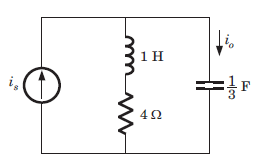This set of Electronic Devices and Circuits Multiple Choice Questions & Answers (MCQs) focuses on “Circuit analysis in S domain”.
1. The network function (s2 + 4s)/(s + 1)(s + 2)(s + 3) represents
a) RC impedance
b) RL impedance
c) LC impedance
d) None of the mentioned
View Answer
Explanation: Poles and zero does not interlace on negative real axis so it is not a immittance function.
2. The network function (3s2 + 8s)/(s + 1)(s + 3) represents
a) RC impedance
b) RL impedance
c) LC impedance
d) None of the mentioned
View Answer
Explanation: The singularity nearest to origin is a zero. So it may be RL impedance or RC admittance function. Because of (D) option it is required to check that it is a valid RC admittance function. The poles and zeros interlace along the negative real axis. The residue of Yrc(s)/s is positive.
3. The network function (s + 1)(s + 4)/s(s + 2)(s + 5) represents
a) RC impedance
b) RL impedance
c) LC impedance
d) All of the mentioned
View Answer
Explanation: The singularity nearest to origin is a pole. So it may be RC impedance or RL admittance function.
4. The network function s^2 + 10s + 24/s2 + 8s + 15 represents
a) RC impedance
b) RL impedance
c) LC impedance
d) None of the mentioned
View Answer
Explanation: The singularity is near to origin is pole. So it may be RC impedance or RL admittance function.
5. A valid immittance function is
a) (s + 4)(s + 8)/(s + 2)(s – 5)
b) s(s + 1)/(s + 2)(s + 5)
c) s(s + 2)(s + 3)/(s + 1)(s + 4)
d) s(s + 2)(s + 6)/(s + 1)(s + 4)
View Answer
Explanation:
a) pole lie on positive real axis
b) poles and zero does not interlace on axis.
c) poles and zero does not interlace on axis.
d) is a valid immittance function.
6. The network function (s2 + 8s +15)/(s2 + 6s + 8) is
a) RL admittance
b) RC admittance
c) LC admittance
d) All of the mentioned
View Answer
Explanation: The singularity nearest to origin is a pole. So it may be a RL admittance or RC impedance function.
7. The voltage response of a network to a unit step input is Vo(s) = 10/s(s2 + 8s + 16). The response is
a) under damped
b) over damped
c) critically damped
d) can’t be determined
View Answer
Explanation: The characteristic equation has real and repeated roots (-4, -4). Hence it is critically damped.
8. The current response of a network to a unit step input is Io(s) = 10(s + 2)/s(s2 + 11s + 30). The response is
a) Under damped
b) Over damped
c) Critically damped
d) None of the mentioned
View Answer
Explanation: The roots are real and unequal (-6, -5) for the characteristic equation. Hence it is over damped.
9. What is the ratio of the transfer function Io/Is?

a) s(s + 4)/(s2 + 3s + 4)
b) s(s + 4)/(s + 1)(s + 3)
c) (s2 + 3s + 4)/s(s + 4)
d) (s + 1)(s + 3)/s(s + 4)
View Answer
Explanation: Io/Is = (s + 4)/ (s + 4 + 3/s) = s(s + 4)/(s + 1)(s + 3).
10. What will be the response for the below figure?

a) Over damped
b) Under damped
c) Critically damped
d) can’t be determined
View Answer
Explanation: The characteristic roots are real and unequal (-1, -3), therefore it is over damped.
Sanfoundry Global Education & Learning Series – Electronic Devices and Circuits.
To practice all areas of Electronic Devices and Circuits, here is complete set of 1000+ Multiple Choice Questions and Answers.
If you find a mistake in question / option / answer, kindly take a screenshot and email to [email protected]
